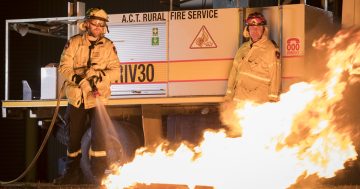
Members of the ACT SES attend the rescue of a woman from Kambah pool. Photo: Supplied.
A nationwide approach to natural disaster warnings will bring emergency services across states and territories onto the same page – helping to protect properties and save lives.
The Australian Warning System (AWS) is expected to be rolled out across the nation by the 2022/23 bushfire season.
Historically, different warning systems for different hazard types have operated across the states and territories. Through community consultation, a single system was chosen to end the confusion.
The AWS will now provide a consistent warning, so every Australian will know what to do when they see each level. The warning levels have been broken down into Advice (yellow), Watch and Act (orange), and Emergency Warning (red).

The new nationwide natural disaster warning system. Image: National Recovery and Resiliency Agency.
The Advice or Yellow warning level means an incident has started but there is no immediate danger. During an Advice warning, affected people will be encouraged to prepare for action, stay informed, monitor conditions and avoid the problem area.
The Watch and Act or Orange warning level means the incident has reached a heightened level of threat, where conditions have changed and protection actions must be taken. During a Watch and Act warning, affected people will be advised to prepare to or evacuate immediately, take shelter, move indoors, and move to a safer area among other potential actions.
The Emergency Warning or Red warning level means an individual could be in immediate danger, and delayed action could put their life at risk. During an Emergency Warning, impacted people will need to evacuate, seek shelter, or it may be too late to leave.
Queanbeyan SES Deputy Unit Commander Brent Hunter said the implications of the system would benefit emergency services and the public.
“We’re all singing from the same song sheet effectively so no matter what the emergency is, the same matrix will apply,” Mr Hunter said.
“You’ll know what the risk is and you can make those decisions yourself. Whether you’re going to stay or go, it puts the power in the public’s hands to better manage their own safety.”
He said while the ACT and NSW had traditionally responded to emergencies across the border effectively, the changes made it slightly easier.
“The new national rollout makes it so no matter where you are in the country, you can follow the same set of emergency standards.”
A nationwide approach to natural disaster warnings was initially announced in late 2020. But it suffered several issues when the AWS rollout stalled in parts of the country, including the ACT and NSW.
















